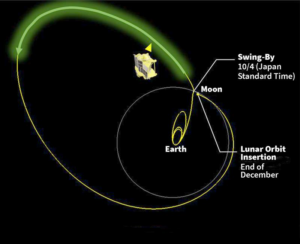Table of Contents
Context: Japan’s SLIM (Smart Lander for Investigating Moon) spacecraft entered lunar orbit, potentially making Japan the fifth country to soft-land a craft on the moon.
Smart Lander for Investigating Moon(SLIM) Spacecraft Overview
- Agency and Launch: Japan Aerospace Exploration Agency (JAXA) was launched on September 7, 2023, from Tanegashima spaceport.
- Weight: 590 kg (India’s Chandrayaan-3- 3,900 kg) and 120 kg without fuel.
- Co-launch: SLIM was sent into space along with XRISM, a next-generation X-ray space telescope, aboard an H-2A rocket.
- Orbital Entry Date: On December 25, SLIM achieved an elliptical lunar orbit. Its orbit around the moon has an apogee of 4,000 km and a perigee of 600 km.
- Comparative Success: JAXA’s launch of SLIM came shortly after the success of India’s Chandrayaan-3 surface component and the failure of Russia’s Luna 25.
- Previous Attempts: SLIM’s launch followed an unsuccessful soft-landing attempt on the moon by the HAKUTO-R M1 lander earlier in the year.

SLIM’s Unique Path: SLIM took four months to reach the moon using a fuel-efficient route based on weak-stability boundary theory.
- This involved multiple loops around Earth, like a slingshot, gradually gaining speed and momentum.
- On getting nearer to the moon, SLIM instead of slowing down and being captured by the moon’s gravity, it allowed itself to be deflected in the moon’s direction. This deflection is the result of the combined forces exerted by the earth and the moon– a planned manoeuvre reminiscent of JAXA’s earlier “Hiten” mission(1980).
We’re now on WhatsApp. Click to Join
SLIM’s Mission and Characteristics
- Precision Landing: Reputed as “moon sniper,” SLIM aims for an unprecedentedly precise landing within 100 metres of its target location, surpassing the 350-metre mark set by Chandrayaan 3’s ‘Vikram’ lander.
- Soft Landing Goal: SLIM seeks to achieve the most accurate soft landing on the moon to date, targeting an area near the Shioli Crater.
- Navigation and Data: It will utilise data from the former JAXA SELENE orbiter mission to aid in its landing precision.
- Mass Advantage: With a mass of just 120 kg without fuel, SLIM’s lower weight contributes to better manoeuvrability and serves as a demonstration of its efficient design.
- Rover Deployment: SLIM plans to deploy two rovers, LEV 1 and LEV 2, to conduct surface studies, gather temperature and radiation data, and explore the possibility of studying the moon’s mantle.
Implications for Chandrayaan 4
Challenging Terrain: The moon’s polar regions are rugged, cratered, and have sharp inclines, which requires a landing craft to touch down as close as possible to the chosen spot, ideally right at the site, to ensure the feasibility of large module or rover operations. This necessitates lower downrange and cross-range limits compared to those for Chandrayaan 3.


 India’s Deep Sea Technology, Need and ...
India’s Deep Sea Technology, Need and ...
 Nag Anti-Tank Missile System (NAMIS)
Nag Anti-Tank Missile System (NAMIS)
 ESA’s Gaia Mission, Scientific Instrum...
ESA’s Gaia Mission, Scientific Instrum...





















